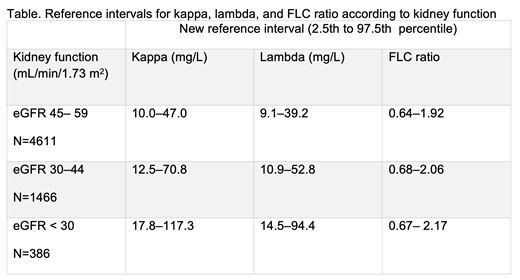Abstract
Background: In addition to serum protein electrophoresis (SPEP) and serum immunofixation (IFE), measurement of serum free light chains (FLC) has become the hallmark for detection, prognostication, and monitoring of monoclonal gammopathies. However, serum FLC levels are heavily dependent on kidney function due to discrepancy in the rate of kidney clearance of the FLC. As chronic kidney disease (CKD) is common in the general population, it is possible that a large number of individuals have false FLC results. A kidney reference interval (eGFR < 60) has previously been published based on small numers (N=688) for serum FLC ratio (0.37-3.10) instead of the standard reference interval (0.26-1.65), but no kidney reference exists for kappa (3.3-19.4mg/L) or lambda (5.7-26.3mg/L). The aim of this study was to define and improve the reference interval for individuals with various degree of decreased kidney function and assess its effect on prevalence of light chain monoclonal gammopathy of undetermined significance (LC-MGUS) among CKD patients.
Methods: A total of 80,759 participants of the Iceland Screens, Treats or Prevents Multiple Myeloma (iStopMM) study were included. Participants were screened by SPEP and IFE as well as by serum FLC assay (Freelite®). Serum creatinine (SCr) value closest to the time of screening was used to calculate (CKD-EPI) eGFR. Participants with M-protein, eGFR >60 mL/min/1.73 m2, missing SCr measurements or more than 1 year from the SCr measurement to the iStopMM screening were excluded. Correlation was assessed graphically and using the Spearman correlation coefficient. A nonparametric bootstrapping method was used to calculate the 95% CI. Partitioning was determined based on the proportion of subgroups (sex, age, eGFR) outside the whole group reference interval (<0.9% or >4.1%). However, intervals were not partitioned if subgroups included few participants and/or if deemed more applicable and reasonable for clinical practice. LC-MGUS was defined as FLC ratio outside the reference interval and raised FLC level without evidence of monoclonal heavy chain on SPEP or IFE or end-organ damage attributed to the plasma cell proliferative disorder.
Results: Of 75,422 individuals who were screened, 6,503 (12%) participants had eGFR < 60 mL/min/1.73 m2, without evidence of monoclonality on SPEP or IFE and were analysed further. The median (IQR) kappa level was 21.7 (16.6-29.4) mg/L, lambda level 19.0 mg/L (14.8-25.0) and FLC ratio 1.16 (0.97-1.39). Serum FLC levels increased with decreasing eGFR: serum free kappa (ρ= -0.44, p < 0.001), lambda (ρ= -0.39, p < 0.001), and FLC ratio (ρ= -0.15, p < 0.001). Using current reference intervals, 60% and 21% of persons had values outside the normal range for kappa and lambda, respectively. The FLC ratio was outside the standard reference interval in 9% and outside the kidney reference interval in 0.6% of participants. Based on these findings, we established new reference intervals for FLC and FLC ratio (Table). Participants on dialysis (N=26) had significantly higher median (IQR) serum free kappa 29.3 mg/L (26.1-57.6, p = 0.01) and lambda 25.1 mg/L (19.5-52.6, p = 0.01) than participants with eGFR 30-59, but no significant difference compared to participants with eGFR < 30 (p = 0.57). The FLC ratio in participants on dialysis was 1.22 (0.96-1.37), which was similar to participants with eGFR 45-59 (p = 0.63) and 30-44 (p = 0.34). Participants on dialysis had significantly lower FLC ratio than participants with eGFR < 30, or 1.31 (1.10-1.57, p = 0.02). Utilising our novel reference intervals, the crude prevalence of LC-MGUS in all participants with eGFR < 60 was 75 (1.2%), with no difference between participants with eGFR of 45-59, 30-44 and < 30, respectively. When the crude rate of LC-MGUS was compared to a rate based on previous reference intervals, the crude rate of both kappa and lambda LC-MGUS increased in participants with eGFR 45-59, eGFR 30-44 and eGFR < 30 (p<0.001).
Conclusion: Current reference intervals for serum FLC and FLC ratio are inaccurate for patients with decreased kidney function. Here we propose new reference intervals for serum FLC and FLC ratio for use in patients with CKD which also seem to be accurate in patients on dialysis. Implementing these novel reference intervals is likely to increase the sensitivity and specificity of the analyses and lead to a more accurate diagnosis of monoclonal gammopathy in individuals with kidney dysfunction.
Kampanis: The Binding Site: Current Employment. Hultcrantz: Intellisphere LLC: Consultancy; Curio Science LLC: Consultancy; GlaxoSmithKline: Membership on an entity's Board of Directors or advisory committees, Research Funding; Amgen: Research Funding; Daiichi Sankyo: Research Funding. Durie: Amgen, Celgene/Bristol-Myers Squibb, Janssen, and Takeda: Consultancy; Amgen: Other: fees from non-CME/CE services . Harding: The Binding Site: Current Employment, Membership on an entity's Board of Directors or advisory committees, Patents & Royalties. Landgren: Janssen: Research Funding; Amgen: Honoraria; Janssen: Honoraria; Celgene: Research Funding; Janssen: Other: IDMC; Takeda: Other: IDMC; Amgen: Research Funding; GSK: Honoraria. Kristinsson: Amgen: Research Funding; Celgene: Research Funding.


This feature is available to Subscribers Only
Sign In or Create an Account Close Modal